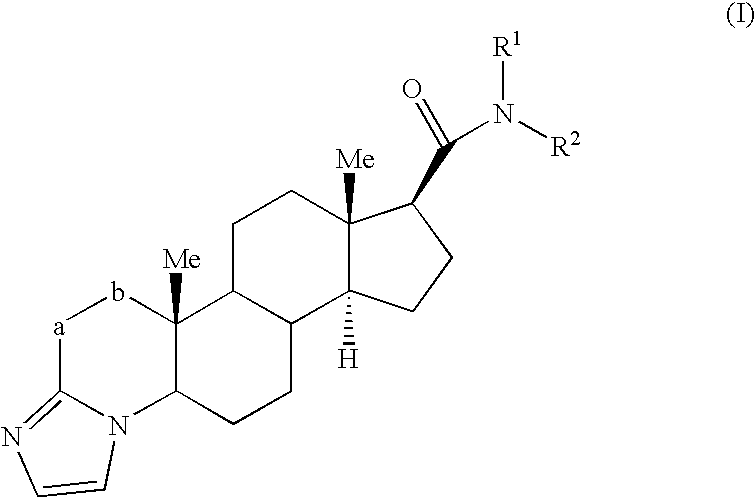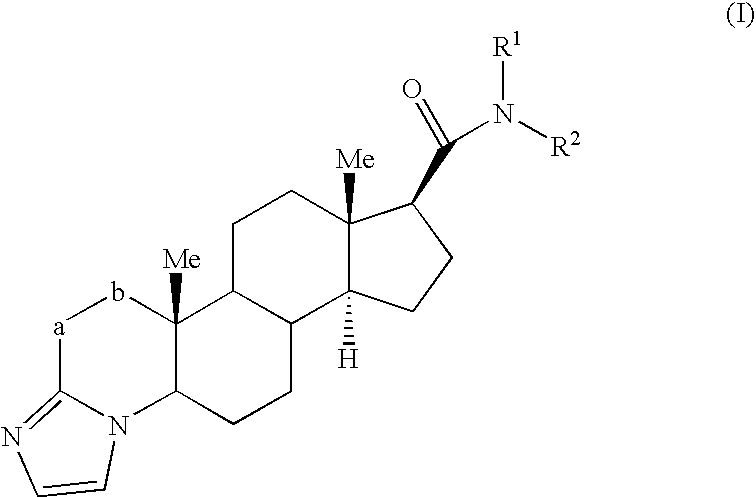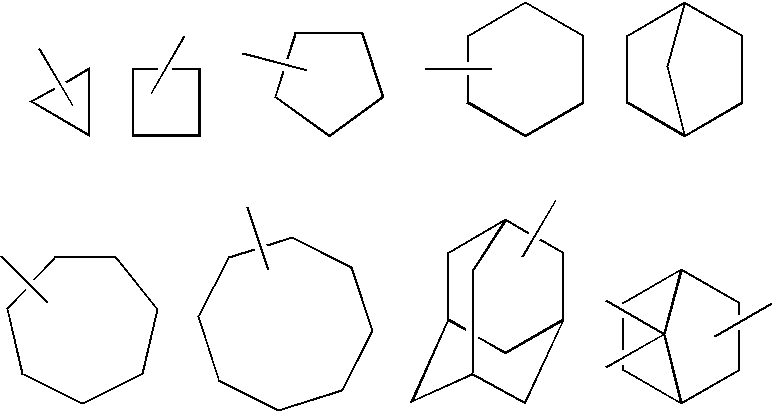Androgen Receptor Modulators
- Summary
- Abstract
- Description
- Claims
- Application Information
AI Technical Summary
Benefits of technology
Problems solved by technology
Method used
Image
Examples
example 1
[0292]
Step A: Ethyl (5aR,5bS,7aS,8R,10aS,10bS)-5b,6,7,7a,8,9,10,10a,10b,11,12,12a-dodecahydro-5aH-imidazo[1,2-a]indeno[5,4-f]quinoline-8-carboxylate (1-b)
[0293] To a stirred suspension of 1-a (5.0 g, 15 mmol) (J. Med. Chem. 29 2298-2315 (1986)) in anhydrous CH2Cl2 / mesitylene (1:2; 60 mL) was added TiCl4 (60 mmol, 1N in CH2Cl2). The mixture was refluxed at 140 ° C. for 20 minutes then removed from heat and briefly air cooled. Aminoacetaldehyde diethyl acetal (12.0 g, 90 mmol) in 10 mL CH2Cl2 was added slowly with stirring. The resulting solution was refluxed at 140 ° C. for 4 hours as CH2Cl2 was collected in a self-pressurizing addition funnel. The reaction mixture was then cooled to RT, neutralized with saturated aqueous sodium bicarbonate, and concentrated to dryness in vacuo. The solid residue was suspended in CH2Cl2 (200 mL). After 30 minutes of stirring, the suspension was filtered through a pad of celite and the filtrate was concentrated in vacuo. The residue was dissolved in ...
example 2
[0297]
Step A: Methyl 2-{[(5aR,5bS,7aS,8R,10aS,10bS)-5,5a,5b,6,7,7a,8,9,10,10a,10b,11,12,12a-tetradecahydro-4H-imidazo[1,2-a]indeno[5,4-f]quinolin-8-ylcarbonyl]amino}butanoate (2-1)
[0298] To a stirred solution of 1-c (0.1 g, 0.3 mmol) in DMF (2 mL) was added EDC (0.08 g, 0.44 mmol), HOAt (0.045 g, 0.3 mmol), DIPEA (0.151 g, 1.2 mmol), and 2-a (1.5 mmol). The resulting mixture was heated in a microwave reactor (150 watts) at 100° C. for 30 minutes. Upon removal of the solvent, the reaction mixture was purified by reversed phase BPLC to afford the title compound 2-1. 1H-NMR (CD3OD); δ 0.75 (d, 3H), 0.90 (d, 3H), 0.97-1.02 (m, 3H), 1.24-1.42 (m, 4H), 1.52-1.65 (m, 3H), 1.72-2.05 (m, 8H), 2.13-2.17 (m, 1H), 2.39-2.49 (m, 2H), 3.72 (d, 3H), 4.09-4.12 (m, 1H), 4.30-4.34 (m, 1H), 6.67 (d, 1H1), 7.09 (m,1H), 7.56 (d, 1H), 7.66(d, 1H). Measured [M+H]=439.9.
[0299] Examples 2-2 to 2-11 in Table 2 were prepared in a similar manner as compound (2-1), but using the appropriate amine to generate ...
example 3
[0300]
Step A: Methyl (5aR,5bS,7aS,8R,10aS,10bS)-5,5a,5b,6,7,7a,8,9,10,10a,10b,11,12,12a-tetradecahydro-4H-imidazo[1,2-a]indeno[5,4-f]quinoline-8-carboxylate (3-b)
[0301] To a stirred suspension of 3-a (5.0 g, 15 mmol)(J. Med. Chem. 29 2298-2315 (1986)) in anhydrous CH2Cl2 / mesitylene (1:2; 60 mL) was added TiCl4 (6.0 mmol, 1N in CH2Cl2). The mixture was refluxed at 140° C. for 20 minutes then removed from heat and briefly air cooled. Aminoacetaldehyde diethyl acetal (12.0 g, 90 mmol) in 10 mL CH2Cl2 was added slowly with stirring. The resulting solution was refluxed at 140° C. for 4 hours as CH2Cl2 was collected in a self-pressurizing addition funnel. The reaction mixture was then cooled to ambient temperature, neutralized with saturated aqueous sodium bicarbonate, and concentrated to dryness in vacuo. The solid residue was suspended in CH2Cl2 (200 mL). After 30 minutes of stirring, the suspension was filtered through a pad of celite and the filtrate was concentrated in vacuo. The re...
PUM
| Property | Measurement | Unit |
|---|---|---|
| Volume | aaaaa | aaaaa |
| Volume | aaaaa | aaaaa |
| Volume | aaaaa | aaaaa |
Abstract
Description
Claims
Application Information
 Login to View More
Login to View More - R&D
- Intellectual Property
- Life Sciences
- Materials
- Tech Scout
- Unparalleled Data Quality
- Higher Quality Content
- 60% Fewer Hallucinations
Browse by: Latest US Patents, China's latest patents, Technical Efficacy Thesaurus, Application Domain, Technology Topic, Popular Technical Reports.
© 2025 PatSnap. All rights reserved.Legal|Privacy policy|Modern Slavery Act Transparency Statement|Sitemap|About US| Contact US: help@patsnap.com



